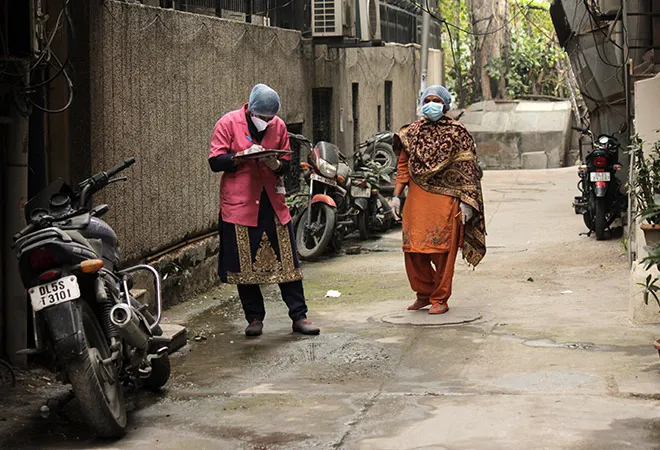India’s Constitutional Day, November 26, saw world’s biggest strike as workers and labour unions around India gathered to observe a ‘Bharat Bandh’ against the Centre’s anti-labour policies. Amongst those observing the strike were India’s flagbearers of care.
India’s care infrastructure hinges on the shoulders of over one million Accredited Social Health Activists (ASHAs) and 2.5 million anganwadi workers and helpers. Despite the essential nature of their work, humongous list of deliverables, and undeniable significance in the pandemic, these frontline care workers are not recognised as workers by their employers – the Government of India. Identified as volunteers working on honorariums and incentive-based pay, these workers comprise only women, who are grossly underpaid and overworked in difficult working conditions.
The treatment of women care workers in India highlights the country’s patriarchal setup and contributes to locking in the gendered division of work, continued undervaluation of women’s labour and care work, and widening gender pay gap.
It is not news that ASHAs, anganwadi workers and helpers have proven to be pivotal for the public provision of care. ASHAs have been crucial in decentralising and strengthening the primary healthcare system in India and have been critically responsible in increasing immunisation and institutional deliveries, while decreasing maternal and infant mortality rates. Anganwadi workers and helpers have been key in enhancing and distributing nutritional needs, monitoring growth and delivering pre-school education in India.
Extra work, little pay amidst the pandemic
In the wake of the pandemic, in addition to visiting households to carry out their regular duties, responsibilities attributed to these care workers have only increased, with tasks including but not limited to monitoring migrants and managing community surveillance.
Furthermore, it is certain that these frontline care workers will be fundamental in the circulation of the COVID-19 vaccine post its roll-out, especially since they already play a central role in facilitating vaccinations in the country. Hence, the essential work performed by women workers is and will continue to be extremely crucial for India.
The government legislated the employment of only women as ASHAs and Anganwadi workers and helpers. This idea emerged as a way to increase women’s participation in the workforce. However, the truth is that it was fundamentally essential to have women exclusively working in these care roles.
The deeply entrenched patriarchy compels society into believing that it is women’s inherent duty to perform unpaid care work. Availability of this extremely essential unpaid care work provides a significant subsidy to the formal economy, especially since care is crucial for the economy to survive and thrive.
Since women’s work is then considered to not be of substantial financial value, women’s labour in formal workforce is also undervalued and mainly reserved for paid care work. This paid work then, despite the skill intensity involved, is also underpaid leading to gender pay gap and the skill level considered to be low, despite contrary evidence.
The ASHA and Anganwadi schemes were built on this exact same setup. The schemes enlisted care duties which were considered to be an extension of women’s unpaid care work at home. Thus, comprising only women in these schemes, allowed the state to cut the otherwise exorbitant costs of providing significant and essential care to the public, by benefitting off women’s undervalued work as the workers were paid less than minimum wage.
These workers are paid monthly honorariums – Rs 3,000 to Anganwadi workers in mini Anganwadi Centres, Rs 4,500 to Anganwadi workers, Rs 2,250 to Anganwadi helpers and a minimum of Rs 2,000 to ASHAs. Further, performance-linked incentives of Rs 250 per month are paid to Anganwadi helpers, while conditional incentives allowed ASHAs to earn additional Rs. 1500- 2000 per month on an average, with state-level variations. But the only way that allowed the government to underpay their care workers to such an extent was through categorising the women involved neither as government employees nor as contractual workers, but only as volunteers.
Hence, when a government public care provision scheme mirrors the patriarchal system, despite helping in pulling women into the workforce, it creates an underlying understanding that care is women’s work – thereby reinforcing the gendered division of labour.
Furthermore, co-opting the extension of this patriarchal system which undervalues women’s labour by paying less than minimum wages to these workers, provides an implicit signal to the market to sustain this undervaluation, thereby nullifying government’s explicit efforts to reduce the gender pay gap.
When you call the flagbearers of providing care mere volunteers and not full-time employees of the government, you do send the message that care, despite being a public good, isn’t valuable enough to be paid properly, and women only deserve equal pay in theory.
The impact of joblessness
Currently, in India joblessness, poverty, and increased income inequality sustains demand for these underpaid and overworked jobs despite regular resistance through strikes and increasingly vacant posts.
In the long term, however, a continued disregard for essential care workers could create a larger gap in public care delivery, ultimately proving fatal for the country. It is, hence, crucial to recognise this essential work by formalising the wages and working conditions of ASHAs and Anganwadi workers and helpers, providing them with social security benefits, and enlisting them as government employees.
Several calls for the same have been made by civil society groups, and even the parliamentary standing committee on labour.
Recognition of these care workers as essential government employees will help create recognition for women’s labour and care work and formalising their work and wages will help in reducing the gender pay gap.
Ultimately, better pay and working conditions will incentivise movement of more women into the workforce. This can be instrumental in bridging the current gaps and expanding the public care delivery system in India.
This will be especially important in the aftermath of the pandemic and the eventual distribution of the COVID-19 vaccine. The pandemic has once again highlighted the importance of ASHAs and Anganwadi workers and helpers, and it is time the state recognises these women and pay its dues!
This commentary originally appeared in The Wire.
The views expressed above belong to the author(s). ORF research and analyses now available on Telegram! Click here to access our curated content — blogs, longforms and interviews.




 PREV
PREV


